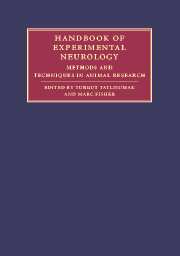Book contents
- Frontmatter
- Contents
- List of contributors
- Part I Principles and general methods
- 1 Introduction: Animal modeling – a precious tool for developing remedies to neurological diseases
- 2 Ethical issues, welfare laws, and regulations
- 3 Housing, feeding, and maintenance of rodents
- 4 Identification of individual animals
- 5 Analgesia, anesthesia, and postoperative care in laboratory animals
- 6 Euthanasia in small animals
- 7 Various surgical procedures in rodents
- 8 Genetically engineered animals
- 9 Imaging in experimental neurology
- 10 Safety in animal facilities
- 11 Behavioral testing in small-animal models: ischemic stroke
- 12 Methods for analyzing brain tissue
- 13 Targeting molecular constructs of cellular function and injury through in vitro and in vivo experimental models
- 14 Neuroimmunology and immune-related neuropathologies
- 15 Animal models of sex differences in non-reproductive brain functions
- 16 The ependymal route for central nervous system gene therapy
- 17 Neural transplantation
- Part II Experimental models of major neurological diseases
- Index
- References
7 - Various surgical procedures in rodents
Published online by Cambridge University Press: 04 November 2009
- Frontmatter
- Contents
- List of contributors
- Part I Principles and general methods
- 1 Introduction: Animal modeling – a precious tool for developing remedies to neurological diseases
- 2 Ethical issues, welfare laws, and regulations
- 3 Housing, feeding, and maintenance of rodents
- 4 Identification of individual animals
- 5 Analgesia, anesthesia, and postoperative care in laboratory animals
- 6 Euthanasia in small animals
- 7 Various surgical procedures in rodents
- 8 Genetically engineered animals
- 9 Imaging in experimental neurology
- 10 Safety in animal facilities
- 11 Behavioral testing in small-animal models: ischemic stroke
- 12 Methods for analyzing brain tissue
- 13 Targeting molecular constructs of cellular function and injury through in vitro and in vivo experimental models
- 14 Neuroimmunology and immune-related neuropathologies
- 15 Animal models of sex differences in non-reproductive brain functions
- 16 The ependymal route for central nervous system gene therapy
- 17 Neural transplantation
- Part II Experimental models of major neurological diseases
- Index
- References
Summary
Principles of surgery
Surgery in laboratory animals, regardless of species and size, is governed by the same principles as those for surgery of human beings.
A basic principle in surgery is Halstead's contribution of not doing harm to the tissue. In fact this is only one of a set of interrelated principles composed of tissue handling and exposure, asepsis and hemostasis.
Tissue handling. Remember that every time you pick up tissue with your instruments, you kill cells. Try to kill as few cells as possible. Be goal-oriented in your approach and remember that sharp dissection is generally less traumatic than blunt dissection.
Exposure. Make sure your view is unobstructed, with proper illumination and physical access. This means that the wound you make should be sufficient in size and certainly not too small. Do not worry about the healing of the wound, as it is not primarily affected by its size, but rather by appropriate approximation of the wound edges.
Asepsis. Conditions favorable to bacterial growth must be avoided. First of all a meticulous sterile technique must be followed. Second, but equally important, dead tissue and foreign materials should be removed together with blood or serum residues.
Hemostasis. Especially in small laboratory animals blood loss can have serious consequences eventually resulting in the untimely death of your animal. Clamping or applying light pressure can stop almost all bleedings. Other ways are coagulation (mono-or bipolar), cauterization, ligation and chemical treatment with collagen and/or ADP-containing hemostatics.
The surgeon
In the beginning the study of surgical and especially microsurgical techniques makes many mental and physical demands.
- Type
- Chapter
- Information
- Handbook of Experimental NeurologyMethods and Techniques in Animal Research, pp. 75 - 113Publisher: Cambridge University PressPrint publication year: 2006



